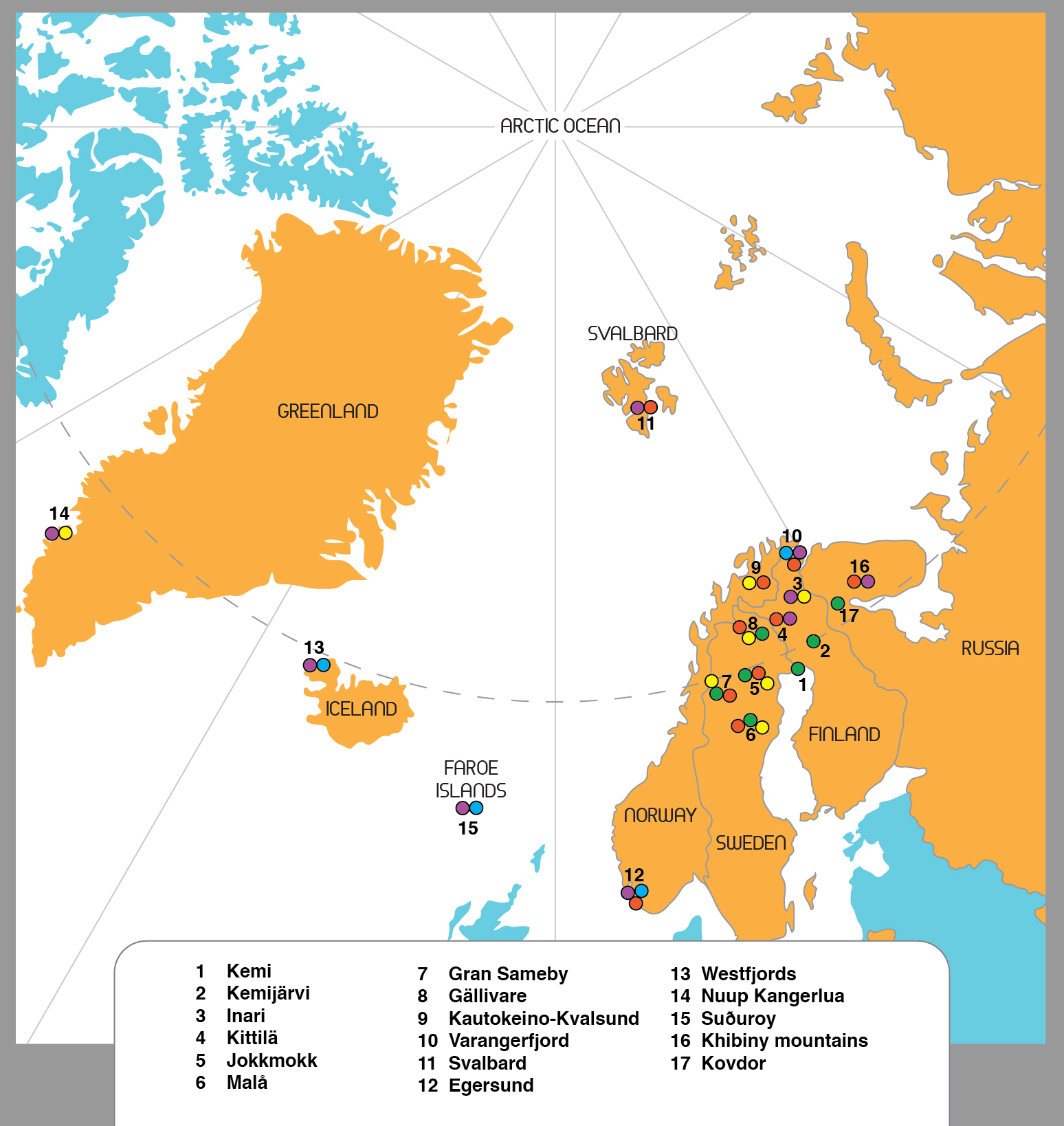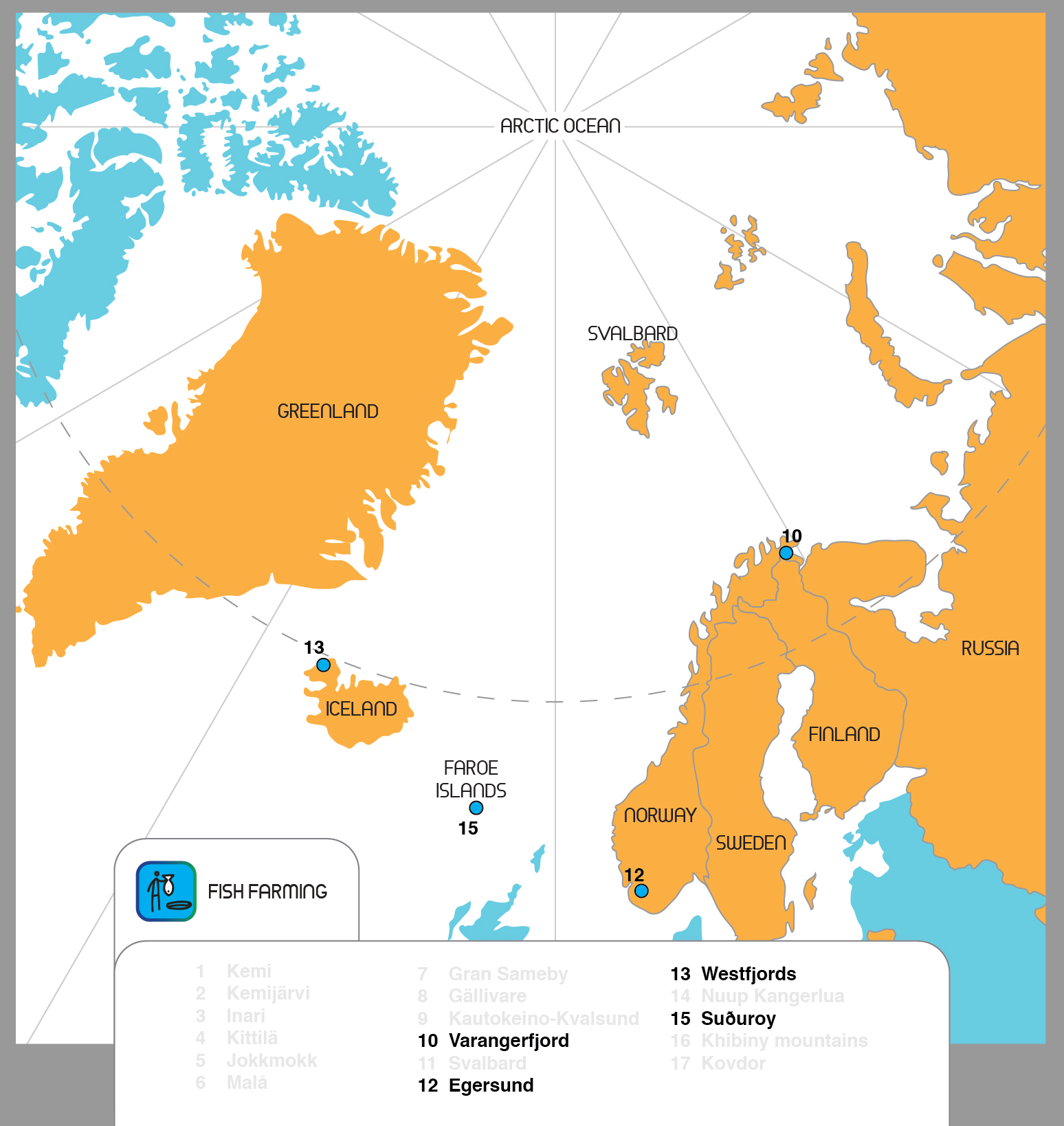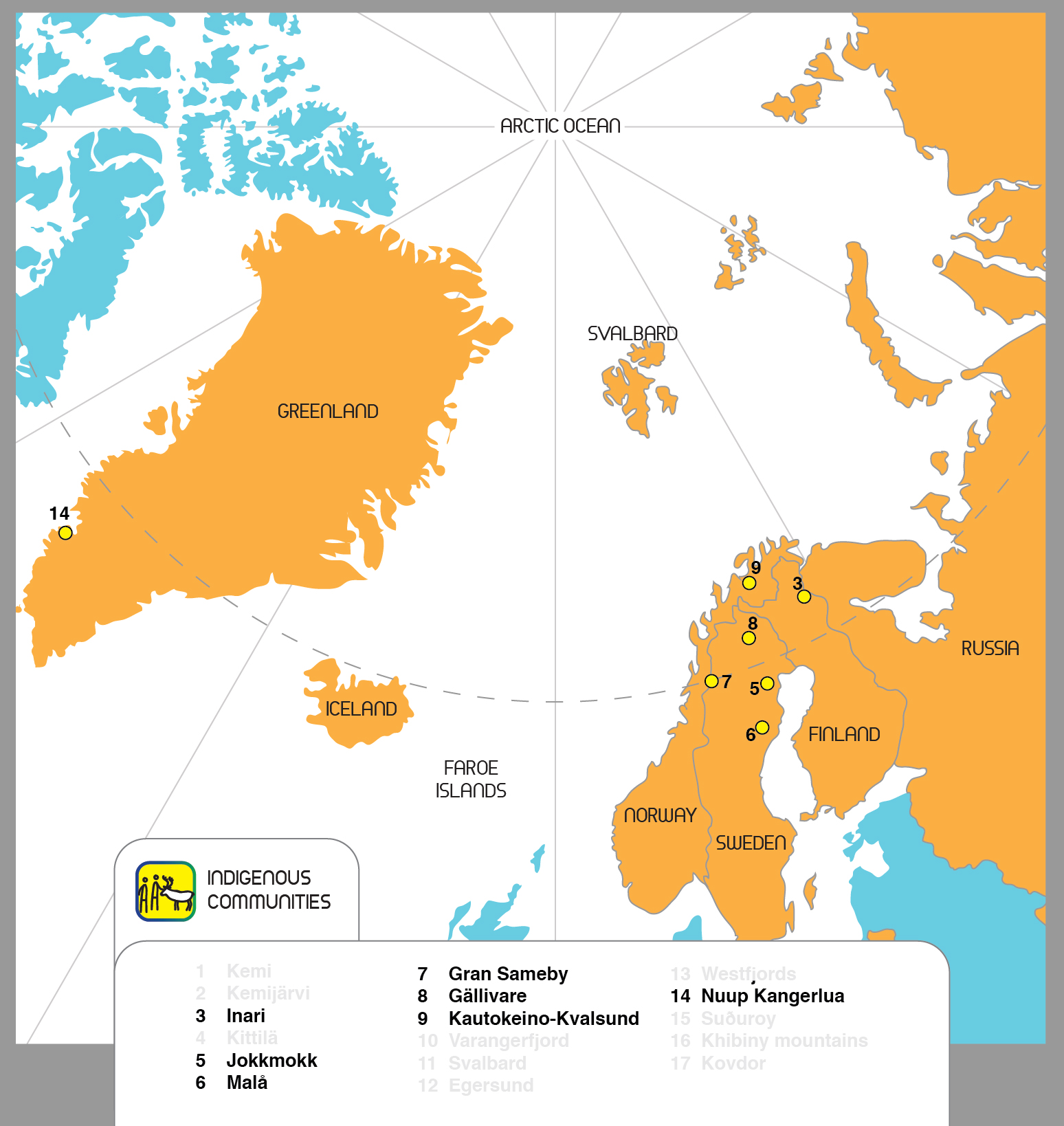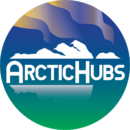At the heart of the ArcticHubs project’s pioneering approach are the 22 ‘hubs’.
What we mean by the term ‘Hubs’
Hubs are nodes hosting either a combination of economic activities, or one main industry or means of livelihood, where the challenges and impacts facing the Arctic region are tangible and acute.
Five main sectorial hubs have been identified inside the Arctic and these are fish farming, forestry, tourism, mining and indigenous hubs. In addition, seven external ‘learning’ hubs, located in Canada, Austria and Italy, will provide points for comparison and control with the Arctic cases.
They are typically focused in historically important locations and draw together relatively densely populated areas surrounded by vast tracts of sparsely populated hinterland.
Hubs have often formed organically or were strategically planned, according to flows of people, goods, capital, information, organizational activities and power relations.
For more on how the project will work, take a look at the Project Impacts page.
Arctic hub locations
(click the coloured buttons to show individual hub types)






And Learning Cases

Numbers in the map above refer to locations of the 22 hubs and 7 learning cases involved in the project:
1. Kemi, Lapland, Finland
Kemi is a small town that has two large pulp mills. Metsä Group cooperative will build a new pulp mill in Kemi that is going to be one of the largest in Europe. At the same time Chinese company Camce is planning a pulp mill in Kemijärvi about 200km away from Kemi. These new pulp mills added together with the existing pulp mills and sawmills have raised concerns about sustainability of the wood use in Northern Finland. This will lead to demand of wood from nearby areas, mainly Sweden and Russia, but also import from overseas areas, mainly Southern America.
2. Kemijärvi, Lapland, Finland
Kemijärvi is the northernmost town in Lapland that has during the past 15 years faced large socio-economical changes due globalisation. In 2003 Nokia moved production of mobile phone charges to China from Kemijärvi. In 2008 Stora Enso closed a large pulp mill in Kemijärvi and sold the factory to Canada. At the moment Chinese company Camce is planning a pulp mill to the place where Stora Enso closed its pulp mill 10 years ago. Like for the Kemi hubs, the pulp mill in Kemijärvi has raised concerns about the sustainability of wood use in Lapland.
3. Inari, Lapland, Finland
Inari is Finland’s largest municipality but extremely sparsely populated. Its major sources of income are tourism, service industry and cold climate testing, and it has long traditions in nature-based tourism. Inari is also a centre for indigenous Sámi culture which serves as a big attraction for tourism. About 60% of the tourist overnights are made by foreign tourists. In addition to bringing work and income, nature-based tourism affects a lot to land use on the wide area. The area of Inari needs to reconcile tourism with other livelihoods, especially reindeer herding. The questions regarding the use of Sámi culture in tourism are also important.
4. Kittilä, Lapland
Kittilä municipality resides in north-western Lapland and has one of the biggest tourist resorts in Finland. The number of registered tourist overnights in Kittilä is over half million, and in addition there are many non-registered overnights in holiday homes. Half of the tourists come from abroad. Tourism has important consequences for the demography of the area since it brings young and female work force and residents to the municipality. The population of Kittilä has been growing recently contrary to other areas in Finnish Lapland.
5. Jokkmokk, Norrbotten, Sweden
Jokkmokk is one of the most prominent centres for Sámi culture. Young Sámi from the whole of Sápmi go to Jokkmokk for education. Jokkmokk is the meeting place for several samebyar (Sámi reindeer herding communities) and located in the heart of their wintering areas. Other competing land use activities include a 100-year history of hydropower developments, tourism and forestry. Forestry has a long history in the area and today is considered by most reindeer herding communities as the most impending threat to reindeer husbandry. Improved and innovative forest activities to reduce loss of landscape connectivity as well as ground and pendulous lichen rich forests is much needed. Such goals can be achieved through improved participatory dialogue between reindeer husbandry and forestry. Today there are no active mines in the Jokkmokk area. There is however, a long-time, ongoing dialogue and conflict around the establishment of the Kallak mine.
6. Malå, Västerbotten, Sweden
Malå is a forestry hub, which also represents a complex land-use situation where mining, wind power developments, and infrastructure projects overlap with the land use needs of Sami reindeer husbandry. The area consists of productive forestlands owned by Sveaskog AB, SCA AB and small private landowners which provide jobs and income both locally and nationally. The Setra sawmill situated in the town of Malå has been in operation since 1946. Mining activities in the Kristineberg mine began in the late 1930s, where Boliden AB extracts zinc, copper, gold and silver. The ore is transported by truck from the mine site to the coastal processing plant in Rönnskär. Malå sameb (Sami reindeer herding community) use the area all year, but also in direct connection with winter lands of Gran sameby. This complex land-use situation calls for innovative participatory tools to provide an effective and inclusive dialogue in search of solutions.
7. Gran Sameby, Västerbotten, Sweden
Gran sameby is a reindeer herding community with extensive territories, a maximum of 7000 reindeer in the culled herd and approximately 50 members centered around 7 families. Gran is an amalgamation of local Ume-Sámi and the North-Sámi that were forcefully moved by the Swedish state, so two distinct languages are spoken. In June of 2019 Vindelälven-Juhttátahkka, which covers vast areas of Gran territory, received the designation as a UNESCO Biosphere Reserve. Gran is an active member on the board, and has since 2013 worked in building knowledge and interacting with other Biosphere Regions and participating in projects with great and useful results. Gran has created close bonds with the Innu First Nation in Pessamit, Manicouagan-Uapishka Biosphere Region, Quebec, Canada.
8. Gällivare, Norrbotten, Sweden
The Gällivare area is part of the traditional lands of Sami people in the greater Sapmi land area. The town of Gällivare is located in central Norrbotten at the meeting point of the three samebyar (Sami reindeer herding communities) Gällivare, Baste Cearru, Unna Tjerusj. Gällivare is a major hub for mining activities. The Malmberget iron mine operated by LKAB is located directly north of Gällivare. Part of the future plans for the Malmberget mine is the establishment of the HYBRIT – fossil free steal production system. On the south side of Gällivare, Boliden Minerals AB operates the Aitik mine and processing plant, established in 1968. Today the Aitik mine has grown into the largest open pit copper mine in Europe covering an area of approximately 50 km2. The Aitik mine is mainly producing copper, but also gold and silver. The Aitik mine employs 770 people and many more are employed in jobs related to the mine. Aitik is expected to be in operation until 2029 but a number of expansions of existing mine are planned and proposed which is expected to prolong operations. Commercial forestry is ongoing throughout the area. Productive forestlands owned by Sveaskog AB, SCA AB and small private landowners also provide jobs and income.
9. Kautokeino-Kvalsund, Finnmark, Norway
Kvalsund is a traditional sea Sámi community and the land resources are used as pastures for reindeer husbandry in spring, summer and autumn. Mining has taken place in the area for shorter periods, last time in the 1970s. Kvalsund needs new employment and a more diversified industrial structure as young people leave the area for more opportunities in the cities. Nussir ASA, a new Norwegian mining company, dependent on foreign investments, planned for 10 years an opening of a copper mine. Nussir received an operating license from the Government in 2019, supported by the local council but plans for a sea deposit in the fjord caused protests from environmental NGOs, Sámi organizations and other user groups.
10. Varangerfjord, Finnmark, Norway
Sydvaranger mine, located outside Kirkenes, has a long history of iron ore mining and processing from 1907. The company town of Kirkenes has a strategic importance next to the Russian border and the state-owned industry should keep employment and settlement in the border region. At its peak, a total of 1600 was employed in the company. The mine closed in 1996 due to low demand and low global iron ore prices. The global mining boom resulted in a restart in Sydvaranger in 2009 by an Australian company but went bankrupt in 2015 followed by a new closure. A new Norwegian initiative based on American investments plans for a reopening of the mine, but on a smaller scale. The new mining initiatives brought forward local consequences affecting the population of the town as well as the landscape with huge landfills. Local opposition to the reopening of the mine is caused by air pollution as well as fjord, lake and river pollution negatively affect the marine life and fish-based industries.
11. Svalbard, Norway
The main settlements on the Spitsbergen islands are the Norwegian Longyearbyen and the Russian Barentsburg. Both are based on long traditions of State-owned coal mining. Other mining communities are now closed. The Archipelago is experiencing a rapid and multifaceted change in climate, industry, tourism, sea ice and glacier extent, terrestrial and marine biology, economic development, and population composition. Coal mining is no longer the main activity in the Norwegian settlements and will be faced out as soon as alternative energy sources for electricity supply are in place. Tourism and research/education are nowadays more important for employment. Increased interests from tourist, especially from the cruise industry, to experience the fragile Arctic nature, is already on the limit of sustainability.
12. Egersund, Rogaland, Norway
The area consists of several abandoned mines extracting feldspar, quartz, molybdenum, wolframite, mica and ilmenite, smaller producing mines extracting sand and gravel, aggregates and dimension stones, and the largest active mine Titania that extract Ilmenite for the pigment marked, which has planned extraction for next 100 years. The mine is the main employer in Sokndal municipality and is owned by the global company Kronos. The tailing deposit from Titania will be full in 12-13 years, so it is urgent to find alternative deposit sites soon. Magma Geopark is working with the abandoned sites to develop tourism and geological heritage.
13. Westfjords, Iceland
There has been rapid development of cultivating Norwegian salmon in open sea cages in the south part of the Westfjords. Three small villages of total 1200 inhabitants are affected by the aquaculture. Two aquaculture companies operate in the villages, which are in majority owned by Norwegian aquaculture companies. They want to expand their production, rationalising the expansion by positive economic impact for the communities, such as population migration and job creation, especially for young higher educated workforce.
14. Nuup Kangerlua, Greenland
The Nuuk Fjord system, Nuup Kangerlua close to the capital is developing as a tourism destination with products of whale watching, kayaking, stand up paddle board, luxury tenting, trophy hunting, and trekking. The hub will document digitally the indigenous and local traditions and locations in nature as a resource to tourism products, and discuss awareness of this resource to lower conflicts of interests.
15. Suðuroy, Faroe Islands
During the last decade, aquaculture production (salmon) has grown in the Faroes from approx. 25,000 tons to more than 71,000 tons. The increased production means that almost every suitable fjord is used for salmon production, and is in some cases displacing other economic practices such as small-scale local fisheries. The local impacts of aquaculture in the Faroes have not been well studied, and future plans to invest in land-based fish-farming will entail further land use changes affecting local communities and environments.
16. Khibiny mountains, Russia
The new created (2018) national park Khibiny shares these territories of Khibiny mountains with 5 mines. The Mountains are an area with a constant influx of Russian and foreign tourists. During the past five years the amount of tourists visiting has increased mainly due to the tourism flows from Asia and Russia. Now we can observe transformation of Kirovsk and Apatity from mining towns into touristic towns trough tourist infrastructure development, and new jobs and businesses creation.
17. Kovdor, Kola Peninsula, Russia
Kovdor is a small town (about 17 000 inhabitants) that has large mining industry with mines and processing-plant. The agriculture and food production are other industries developed in Kovdor. Pine forests, mainly derivatives (after logging) grow around the Kovdor town. Multifunctional forest ecosystems are, first of all, links between biodiversity and ecosystem services / ecosystem functions of forests. Forest vegetation provides a variety of non-timber forest products – wild berries and mushrooms, medicinal plants, material used for various handicrafts and others.
18. Ennstaler Alpen, Styria, Austria
The Austrian Federal Forests (ÖBF AG) are responsible for managing 17% of the forest area in Austria. In the area of the Ausseerland nature conservation is of high importance by the implementation of an ongoing Life project. Additionally, the protection against rockfall and erosion is of high interest for the municipalities and infrastructure providers. There is an interest to quantify the monetary compensations (extra costs) in implementing nature conservation measures and/or develop new system of payments for FES related to recreation (voluntary payments through web-based auctioning platform). Increased number of tourists, coming mainly from Asia and Arabia, are visiting the area. There is an ongoing interest of different nationalities to stay in Austria for the summer vacation, which requires new strategies in marketing and sustainable solutions for utilizing the natural resources.
19. Liezen, Styria, Austria
The forest enterprise Franz Mayr-Melnhof-Saurau working in the area is the largest private forest enterprise in Austria. The area is dominated by montane to subalpine mixed forests of Norway Spruce, Beech, Silver Fir and Larch also in mosaic with agricultural land in lower parts, mixed and pure spruce mountain forests and alpine meadows on the upper limit. Timber production is the main service provided, but increasing interest is in the utilisation of non-timber forest products embedded in recreation services in order to diversify the income portfolio for land owners. New businesses from local farmers and forest land owners are developed in Liezen in order to increase the family income.
20. Alagna Valsesia, Italy
Alagna is an alpine town of Upper Valsesia, NW Alps. It is the access point to the North face of Monte Rosa. It has preserved its alemanic language, culture and architecture. Present day permanent resident population is about 600 inhabitants, while during winter season over 5000 tourists per day are present. Due to its particular alpine geomorphological conditions Alagna Valsesia is nowadays internationally known for being the free ride ski capital of the Alps. New development of the industry of tourism are now under regional and local debate from an environmental point of view, because of possible issues related to: 1) interactions with the Sesia Val Grande UNESCO Global Geopark and Alta Valsesia Regional Park); 2) climate change effects on both mountain environment and the potential of ski resorts; 3) energy consumption and waste production related to increasing tourism infrastructure.
21. Germanasca Valley, Italy
The character of the Germanasca Valley is the Western Alps, linked to the mining resources and to the history of the Waldenses (religious group born in 1173 in Lyon) marked by persecution and the fight for their own identity. This case illustrates an interaction between local population and a mining company. After centuries of the intense mining, in 1993, an ambitious project for rediscovery the abandoned talc mines led to the birth of the “EcoMuseum of Mining “. Later a new Geoscience educational project “ScopriAlpi” (DiscoverAlps) was built for showing the internal geological structure of the Alps. The local mining activity managed by IMERYS TALC ITALY involves the whole Germanasca valley. The talc extracted from the Rodoretto mine in the municipality of Prali undergoes its first screening in the sorting station before it is transported to the Malanaggio.
22. Halifax, Nova Scotia, Canada
In Nova Scotia many industries are operating within the same area. There are also many new and legacy mines, some of which have had conflicts with local communities who rely on shellfish aquaculture, lobster fishing and also tourism. In tourism industry Nova Scotia is known as “Canada’s Ocean Playground”.
